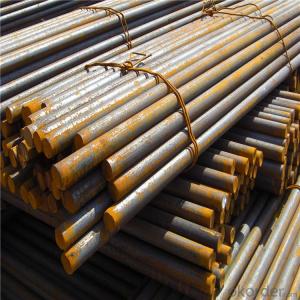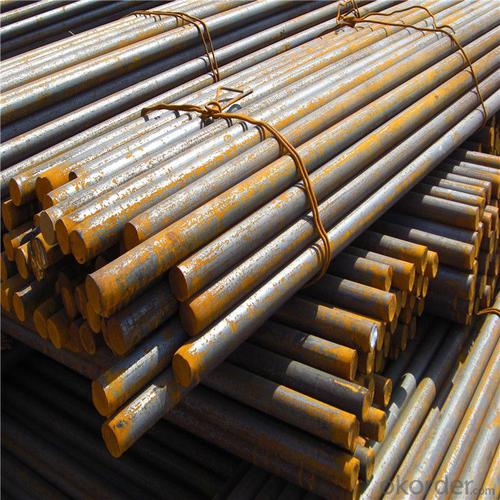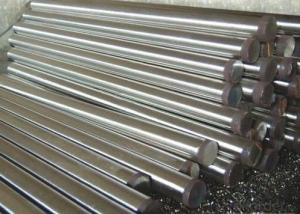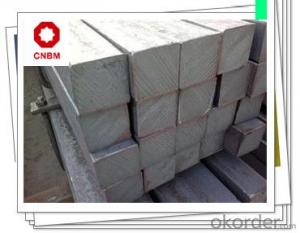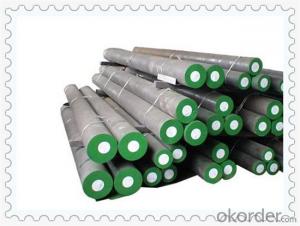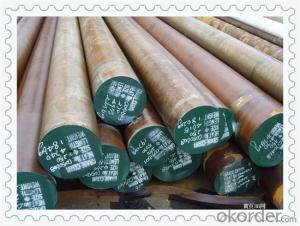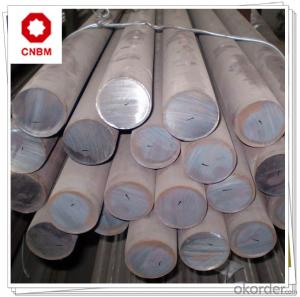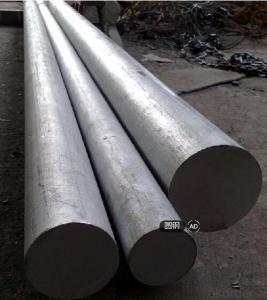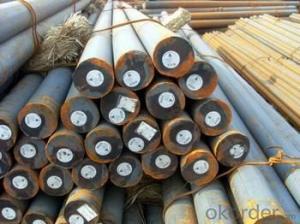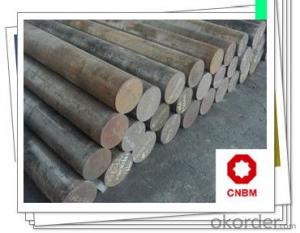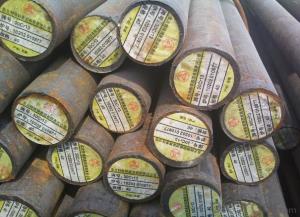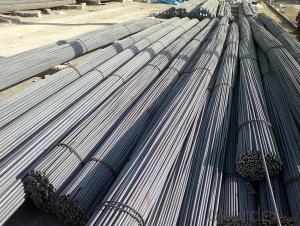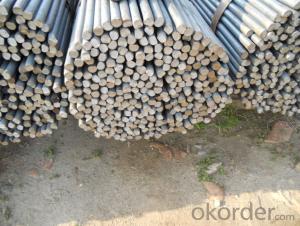A36 Steel Round Bar Round Bar EN19 ST37-2 Steel Round Bar
- Loading Port:
- Tianjin
- Payment Terms:
- TT OR LC
- Min Order Qty:
- 100 m.t.
- Supply Capability:
- 500000 m.t./month
OKorder Service Pledge
OKorder Financial Service
You Might Also Like
Specification
A36 Steel Round Bar Round Bar EN19 ST37-2 Steel Round Bar
Product Description of A36 Steel Round Bar Round Bar EN19 ST37-2 Steel Round Bar
1. Steel grade: ASTM4140, SCM440, 42CrMo, DIN1.7225
2. Length: 6M-12M
3. Diameter: 16mm-300mm
4. Product range: round bar, flat bar, square bar
5. Technique: Hot rolled, forged, cold drawn
Specification of A36 Steel Round Bar Round Bar EN19 ST37-2 Steel Round Bar
Material | SCM4140 | Round bar | Dia(mm) | 16-300mm |
Process | EAF + LF + VD + Forged + Heat Treatment (optional) | Length (mm) | Max 12m | |
Heat treatment | Normalized / Annealed / Quenched / tempered | Flat bar | Thickness(mm) | 8-500mm |
Delivery condition | Hot forged +Rough machined (black surface after Q/T)+ Turned (optional) | Width(mm) | 70-200mm | |
Test | Ultrasonic test according to SEP 1921-84 D/d | Length (mm) | Max 12m |
Chemical Composition of A36 Steel Round Bar Round Bar EN19 ST37-2 Steel Round Bar
C | Si | Mn | Cr | Mo | P | S |
0.38~0.43 | 0.15~0.35 | 0.75~1.00 | 0.8~1.1 | 0.15~0.25 | ≤0.035 | <0.04< td=""> |
Photo Show of A36 Steel Round Bar Round Bar EN19 ST37-2 Steel Round Bar
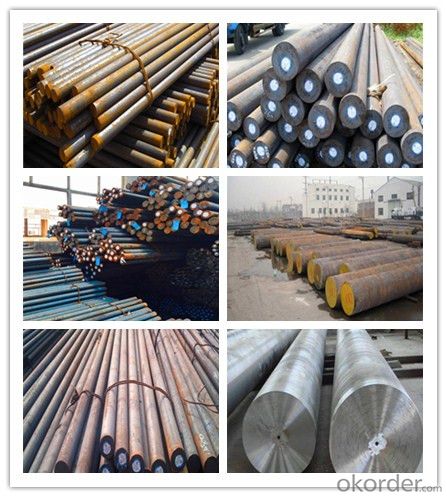
Packing and Delivery:
Packing in bundle package, or as customer's requirements.
Delivery Detail: 45 days after receiving the deposit.
Usage and Applications of A36 Steel Round Bar Round Bar EN19 ST37-2 Steel Round Bar
1. Steel round bar is used in a large number of architectural and engineering structures. Or it can be used in construction of plants for the production of steel house frames, high-voltage transmission towers, bridges, vehicles, boilers, containers, ships, etc.
2. And we can use this kind of product on the performance of the mechanical parts if the demand is not very high.
3. Some special material steel round bar can be used for main shaft of steamer, hummer shank, with big section and supper force.
Company Information
CNBM International Corporation is the most important trading platform of CNBM group.
Whith its advantages, CNBM International are mainly concentrate on Cement, Glass, Iron and Steel, Ceramics industries and devotes herself for supplying high qulity series of refractories as well as technical consultancies and logistics solutions.


F A Q
1, Your advantages?
professional products inquiry, products knowledge train (for agents), smooth goods delivery, excellent customer solution proposale
2, Test & Certificate?
SGS test is available, customer inspection before shipping is welcome, third party inspection is no problem
3, Factory or Trading Company?
CNBM is a trading company but we have so many protocol factories and CNBM works as a trading department of these factories. Also CNBM is the holding company of many factories.
4, Payment Terms?
30% TT as deposit and 70% before delivery.
Irrevocable L/C at sight.
5, Trading Terms?
EXW, FOB, CIF, FFR, CNF
6, After-sale Service?
CNBM provides the services and support you need for every step of our cooperation. We're the business partner you can trust.
For any problem, please kindly contact us at any your convenient time.
We'll reply you in our first priority within 24 hours.
- Q: Can steel round bars be machined?
- Steel round bars have the capability to undergo machining. Machining is a procedure that entails eliminating material from a workpiece in order to achieve the desired form, size, or texture. Steel round bars are frequently machined for the purpose of creating various components, including shafts, bolts, and fasteners. Turning, milling, drilling, and grinding are some of the machining processes that can be employed to shape and cut the steel round bars. However, the machinability of steel can differ depending on factors such as the steel's composition, hardness, cutting tools, and machining parameters. It is crucial to employ appropriate machining techniques and tools in order to ensure accurate and efficient outcomes when machining steel round bars.
- Q: What are the different types of steel round bar alloys for improved hardness and strength?
- Improved hardness and strength are characteristics associated with various types of steel round bar alloys. Some commonly used alloys renowned for these qualities include: 1. Carbon Steel: Exceptional strength and hardness make carbon steel a popular choice. Its higher carbon content enhances durability and resistance to wear and tear. 2. Alloy Steel: Combining carbon steel with elements like manganese, nickel, chromium, or vanadium results in alloy steel. These additions enhance hardness and strength, making it suitable for applications requiring high tensile strength and toughness. 3. Stainless Steel: With a minimum chromium content of 10.5%, stainless steel is a corrosion-resistant alloy. Chromium's addition improves hardness and strength, making it ideal for applications demanding resistance to corrosion, heat, and wear. 4. Tool Steel: Tool steel is tailor-made for manufacturing various tools. It boasts high hardness, wear resistance, and strength. Elements like tungsten, molybdenum, or vanadium are often added to enhance its performance. 5. High-Speed Steel: Developed specifically for high-speed cutting tools like drills and milling cutters, high-speed steel excels in hardness and retains its cutting edge even at high temperatures. 6. Maraging Steel: Maraging steel, a low-carbon, high-nickel alloy, stands out for its exceptional strength, toughness, and resistance to fatigue. It finds applications in industries like aerospace and defense that demand high strength and durability. These examples merely scratch the surface of the steel round bar alloys known for improved hardness and strength. The choice of alloy depends on the intended application and desired properties for the final product.
- Q: What are the advantages of using nickel-alloy steel round bars?
- There are several advantages of using nickel-alloy steel round bars. Firstly, nickel-alloy steel has excellent corrosion resistance, making it suitable for use in harsh environments or applications where the material is exposed to corrosive elements. Secondly, nickel-alloy steel possesses high temperature strength and resistance to thermal expansion, making it ideal for use in high-temperature applications such as aerospace or power generation. Additionally, nickel-alloy steel offers good mechanical properties, including high tensile strength and toughness, which make it suitable for demanding applications that require strength and durability. Overall, the use of nickel-alloy steel round bars provides a combination of corrosion resistance, high-temperature strength, and mechanical properties, making it a versatile and reliable material choice in various industries.
- Q: Can steel round bars be used in the production of medical equipment?
- Yes, steel round bars can be used in the production of medical equipment. Steel is known for its durability, strength, and resistance to corrosion, making it suitable for manufacturing various medical instruments and equipment. Steel round bars can be used to create components such as surgical tools, implants, orthopedic devices, and many other medical apparatus.
- Q: What is the difference between a centerless ground and a cold finished steel round bar?
- A centerless ground steel round bar and a cold finished steel round bar are both types of steel bars that have undergone different manufacturing processes, resulting in distinct characteristics and properties. A centerless ground steel round bar is produced by feeding a hot rolled or cold drawn steel bar through a grinding machine. This process removes any surface imperfections or irregularities, resulting in a smooth and uniform surface finish. The centerless grinding process also ensures tight dimensional tolerances, making the bar suitable for applications that require precise measurements. Additionally, centerless ground bars have improved straightness and roundness, which enhances their overall quality and suitability for various machining operations. On the other hand, a cold finished steel round bar is produced by cold drawing or cold rolling a hot rolled steel bar. This process involves reducing the diameter of the bar while maintaining its length, resulting in a more precise and consistent size. Cold finishing also improves the surface finish of the bar, making it smoother and more uniform. Cold finished bars have tighter dimensional tolerances and improved mechanical properties, including higher strength and hardness compared to hot rolled bars. In summary, the main difference between a centerless ground and a cold finished steel round bar lies in the manufacturing processes used and their resulting characteristics. Centerless ground bars have a smooth surface finish, tight dimensional tolerances, improved straightness, and roundness, making them suitable for precise machining applications. Cold finished bars, on the other hand, have a more precise size, improved surface finish, tighter dimensional tolerances, and enhanced mechanical properties, making them suitable for various applications requiring higher strength and hardness.
- Q: Can steel round bars be used for making fasteners or bolts?
- Yes, steel round bars can be used for making fasteners or bolts. Steel is a commonly used material for fasteners and bolts due to its high strength, durability, and resistance to corrosion. Round bars made of steel can be easily machined and threaded to create various types of fasteners and bolts, including screws, nuts, and threaded rods. The specific grade of steel used would depend on the application and required strength properties. However, it is important to note that the manufacturing process and quality control are crucial in ensuring the reliability and performance of the final product.
- Q: What are the different surface finishes for stainless steel round bars?
- There are several different surface finishes available for stainless steel round bars, including bright annealed, mill finish, brushed, polished, and satin. Each finish offers a distinct appearance and level of smoothness, allowing for various aesthetic and functional preferences.
- Q: What are the applications of steel round bars?
- Due to their inherent strength, durability, and versatility, steel round bars find extensive applications across various industries. They play a crucial role in: 1. Construction: Steel round bars are widely used in the construction industry for structural purposes. They provide stability and safety in building columns, beams, and frames due to their high strength-to-weight ratio. 2. Manufacturing: The manufacturing sector heavily relies on steel round bars for fabricating components and machinery. They are essential in producing gears, shafts, axles, and other machine parts that demand precision and strength. 3. Automotive industry: Steel round bars are significant in manufacturing crankshafts, connecting rods, suspension components, and other automobile parts. They contribute to the strength and reliability of vehicles. 4. Oil and gas industry: The oil and gas sector utilizes steel round bars in manufacturing drill bits, valves, pipes, and equipment exposed to harsh environmental conditions. These bars offer high strength and corrosion resistance. 5. Aerospace industry: The aerospace industry heavily depends on steel round bars for their high strength and lightweight properties. They are used in aircraft components such as landing gear, engine parts, and structural elements. 6. Shipbuilding: Steel round bars are commonly employed in shipbuilding due to their excellent strength and corrosion resistance. They are used in constructing ship frames, hulls, and critical components that require durability in harsh marine environments. 7. Infrastructure projects: Steel round bars are extensively used in infrastructure projects like bridges, tunnels, and railways. They provide the necessary strength and stability to support heavy loads and ensure the structural integrity of these projects. 8. Furniture and interior design: Steel round bars also find applications in the furniture and interior design industry. They are commonly used in the construction of chairs, tables, shelves, and other furniture pieces due to their sleek appearance, durability, and ease of molding. In conclusion, steel round bars have a wide range of applications in various industries, contributing to the development of robust and reliable structures, machinery, and equipment.
- Q: What is the difference between a bright and a rough turned steel round bar?
- A bright turned steel round bar and a rough turned steel round bar differ primarily in their surface finish and the level of precision involved in their manufacturing processes. A bright turned steel round bar has a smooth, shiny surface finish. This is achieved by subjecting the bar to additional processes such as polishing or grinding after the initial turning operation. The bright surface finish gives the bar an aesthetically pleasing appearance and can also provide improved corrosion resistance. On the other hand, a rough turned steel round bar has a more textured surface finish. It is typically obtained directly from the turning operation without any additional processes to refine the surface. The rough surface finish may have visible tool marks and a slightly uneven texture. In terms of manufacturing precision, a bright turned steel round bar is typically more accurate and precise in terms of its dimensions and tolerances. The additional processes involved in achieving a bright surface finish also allow for tighter control over the bar's specifications. This makes bright turned bars suitable for applications where precise dimensions and tolerances are critical. In contrast, a rough turned steel round bar may have slightly looser tolerances due to the nature of the turning process and the lack of additional refining operations. However, the rough turned bars can still meet the requirements of many applications that do not require high precision. Overall, the choice between a bright and a rough turned steel round bar will depend on the specific application and the desired surface finish and precision.
- Q: Are steel round bars available in metric sizes?
- Yes, steel round bars are available in metric sizes.
Send your message to us
A36 Steel Round Bar Round Bar EN19 ST37-2 Steel Round Bar
- Loading Port:
- Tianjin
- Payment Terms:
- TT OR LC
- Min Order Qty:
- 100 m.t.
- Supply Capability:
- 500000 m.t./month
OKorder Service Pledge
OKorder Financial Service
Similar products
Hot products
Hot Searches
Related keywords
